Analysis of Tesco's Change Management Strategies and Approaches
VerifiedAdded on 2020/07/22
|17
|5355
|50
Report
AI Summary
This report provides an in-depth analysis of Tesco's change management strategies. It begins with an introduction to change management and its importance for organizational success, particularly within the retail sector. The report then presents an organizational profile of Tesco and outlin...
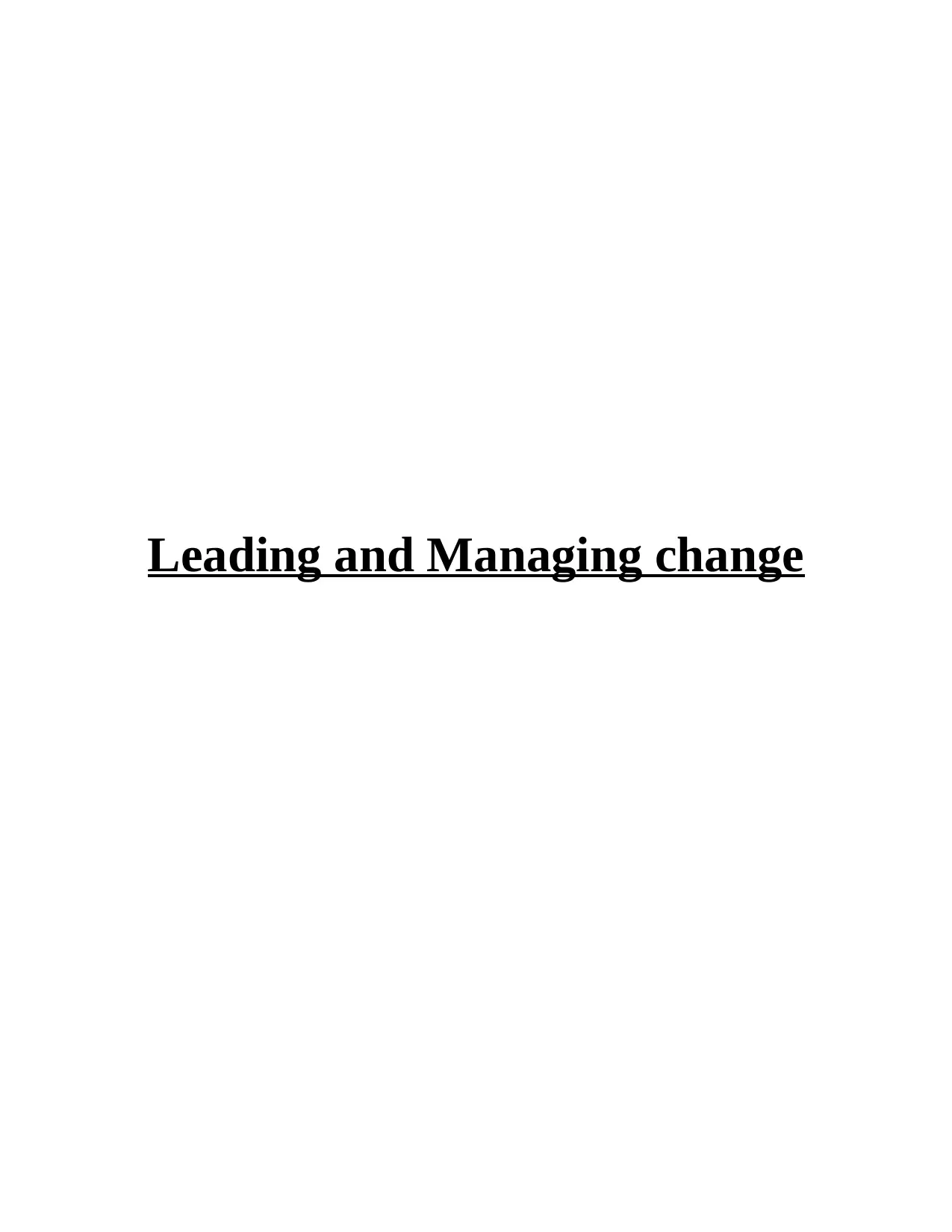
Leading and Managing change
Paraphrase This Document
Need a fresh take? Get an instant paraphrase of this document with our AI Paraphraser
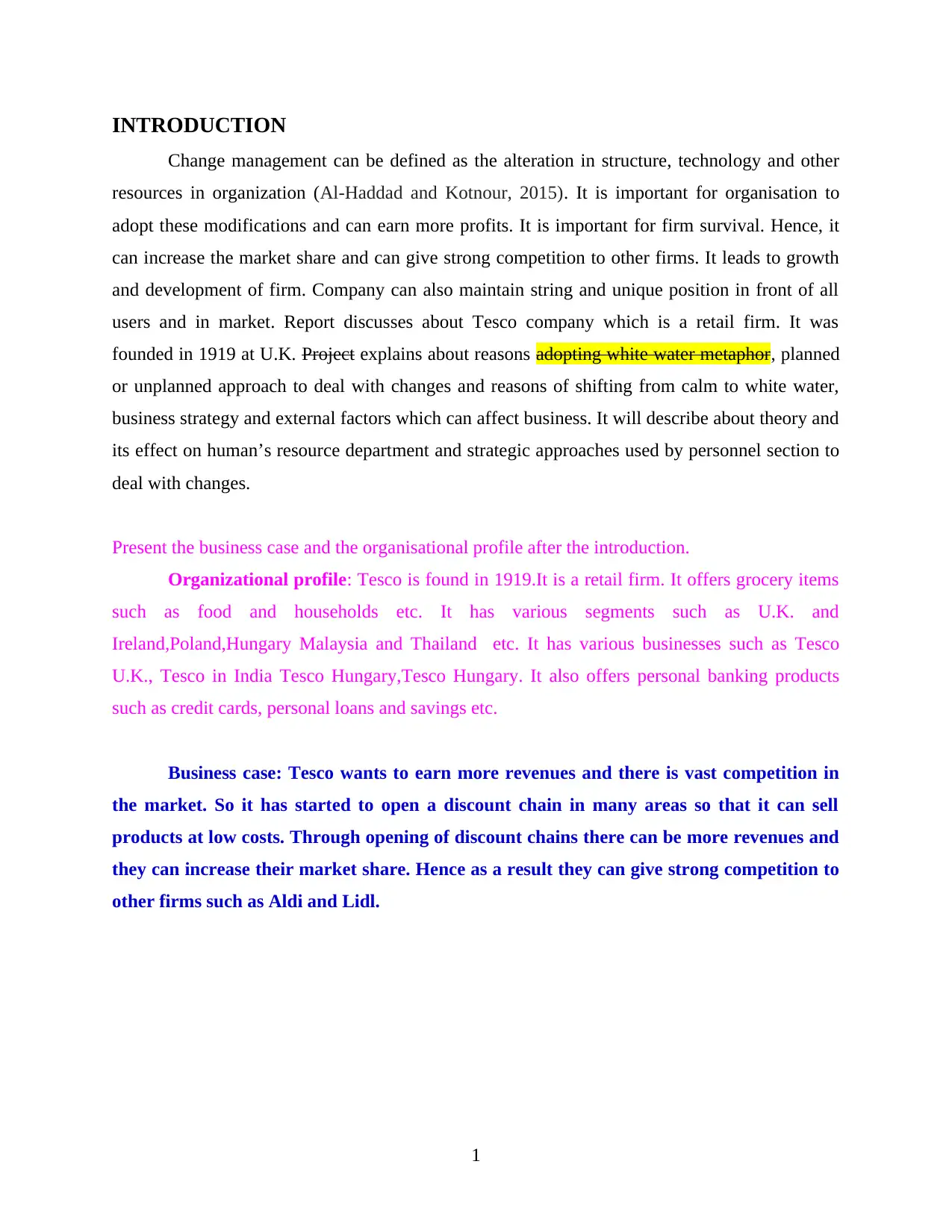
INTRODUCTION
Change management can be defined as the alteration in structure, technology and other
resources in organization (Al-Haddad and Kotnour, 2015). It is important for organisation to
adopt these modifications and can earn more profits. It is important for firm survival. Hence, it
can increase the market share and can give strong competition to other firms. It leads to growth
and development of firm. Company can also maintain string and unique position in front of all
users and in market. Report discusses about Tesco company which is a retail firm. It was
founded in 1919 at U.K. Project explains about reasons adopting white water metaphor, planned
or unplanned approach to deal with changes and reasons of shifting from calm to white water,
business strategy and external factors which can affect business. It will describe about theory and
its effect on human’s resource department and strategic approaches used by personnel section to
deal with changes.
Present the business case and the organisational profile after the introduction.
Organizational profile: Tesco is found in 1919.It is a retail firm. It offers grocery items
such as food and households etc. It has various segments such as U.K. and
Ireland,Poland,Hungary Malaysia and Thailand etc. It has various businesses such as Tesco
U.K., Tesco in India Tesco Hungary,Tesco Hungary. It also offers personal banking products
such as credit cards, personal loans and savings etc.
Business case: Tesco wants to earn more revenues and there is vast competition in
the market. So it has started to open a discount chain in many areas so that it can sell
products at low costs. Through opening of discount chains there can be more revenues and
they can increase their market share. Hence as a result they can give strong competition to
other firms such as Aldi and Lidl.
1
Change management can be defined as the alteration in structure, technology and other
resources in organization (Al-Haddad and Kotnour, 2015). It is important for organisation to
adopt these modifications and can earn more profits. It is important for firm survival. Hence, it
can increase the market share and can give strong competition to other firms. It leads to growth
and development of firm. Company can also maintain string and unique position in front of all
users and in market. Report discusses about Tesco company which is a retail firm. It was
founded in 1919 at U.K. Project explains about reasons adopting white water metaphor, planned
or unplanned approach to deal with changes and reasons of shifting from calm to white water,
business strategy and external factors which can affect business. It will describe about theory and
its effect on human’s resource department and strategic approaches used by personnel section to
deal with changes.
Present the business case and the organisational profile after the introduction.
Organizational profile: Tesco is found in 1919.It is a retail firm. It offers grocery items
such as food and households etc. It has various segments such as U.K. and
Ireland,Poland,Hungary Malaysia and Thailand etc. It has various businesses such as Tesco
U.K., Tesco in India Tesco Hungary,Tesco Hungary. It also offers personal banking products
such as credit cards, personal loans and savings etc.
Business case: Tesco wants to earn more revenues and there is vast competition in
the market. So it has started to open a discount chain in many areas so that it can sell
products at low costs. Through opening of discount chains there can be more revenues and
they can increase their market share. Hence as a result they can give strong competition to
other firms such as Aldi and Lidl.
1
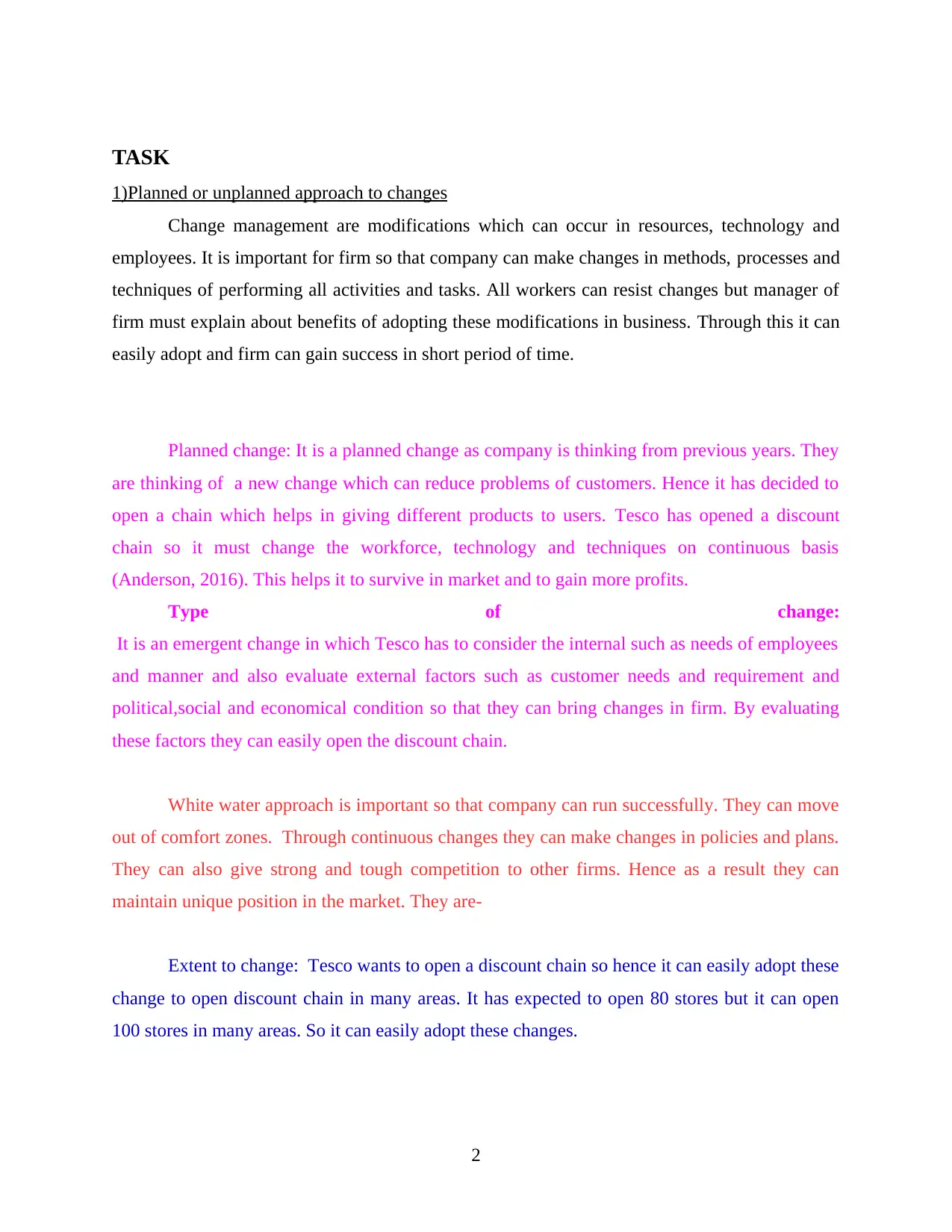
TASK
1)Planned or unplanned approach to changes
Change management are modifications which can occur in resources, technology and
employees. It is important for firm so that company can make changes in methods, processes and
techniques of performing all activities and tasks. All workers can resist changes but manager of
firm must explain about benefits of adopting these modifications in business. Through this it can
easily adopt and firm can gain success in short period of time.
Planned change: It is a planned change as company is thinking from previous years. They
are thinking of a new change which can reduce problems of customers. Hence it has decided to
open a chain which helps in giving different products to users. Tesco has opened a discount
chain so it must change the workforce, technology and techniques on continuous basis
(Anderson, 2016). This helps it to survive in market and to gain more profits.
Type of change:
It is an emergent change in which Tesco has to consider the internal such as needs of employees
and manner and also evaluate external factors such as customer needs and requirement and
political,social and economical condition so that they can bring changes in firm. By evaluating
these factors they can easily open the discount chain.
White water approach is important so that company can run successfully. They can move
out of comfort zones. Through continuous changes they can make changes in policies and plans.
They can also give strong and tough competition to other firms. Hence as a result they can
maintain unique position in the market. They are-
Extent to change: Tesco wants to open a discount chain so hence it can easily adopt these
change to open discount chain in many areas. It has expected to open 80 stores but it can open
100 stores in many areas. So it can easily adopt these changes.
2
1)Planned or unplanned approach to changes
Change management are modifications which can occur in resources, technology and
employees. It is important for firm so that company can make changes in methods, processes and
techniques of performing all activities and tasks. All workers can resist changes but manager of
firm must explain about benefits of adopting these modifications in business. Through this it can
easily adopt and firm can gain success in short period of time.
Planned change: It is a planned change as company is thinking from previous years. They
are thinking of a new change which can reduce problems of customers. Hence it has decided to
open a chain which helps in giving different products to users. Tesco has opened a discount
chain so it must change the workforce, technology and techniques on continuous basis
(Anderson, 2016). This helps it to survive in market and to gain more profits.
Type of change:
It is an emergent change in which Tesco has to consider the internal such as needs of employees
and manner and also evaluate external factors such as customer needs and requirement and
political,social and economical condition so that they can bring changes in firm. By evaluating
these factors they can easily open the discount chain.
White water approach is important so that company can run successfully. They can move
out of comfort zones. Through continuous changes they can make changes in policies and plans.
They can also give strong and tough competition to other firms. Hence as a result they can
maintain unique position in the market. They are-
Extent to change: Tesco wants to open a discount chain so hence it can easily adopt these
change to open discount chain in many areas. It has expected to open 80 stores but it can open
100 stores in many areas. So it can easily adopt these changes.
2
You're viewing a preview
Unlock full access by subscribing today!
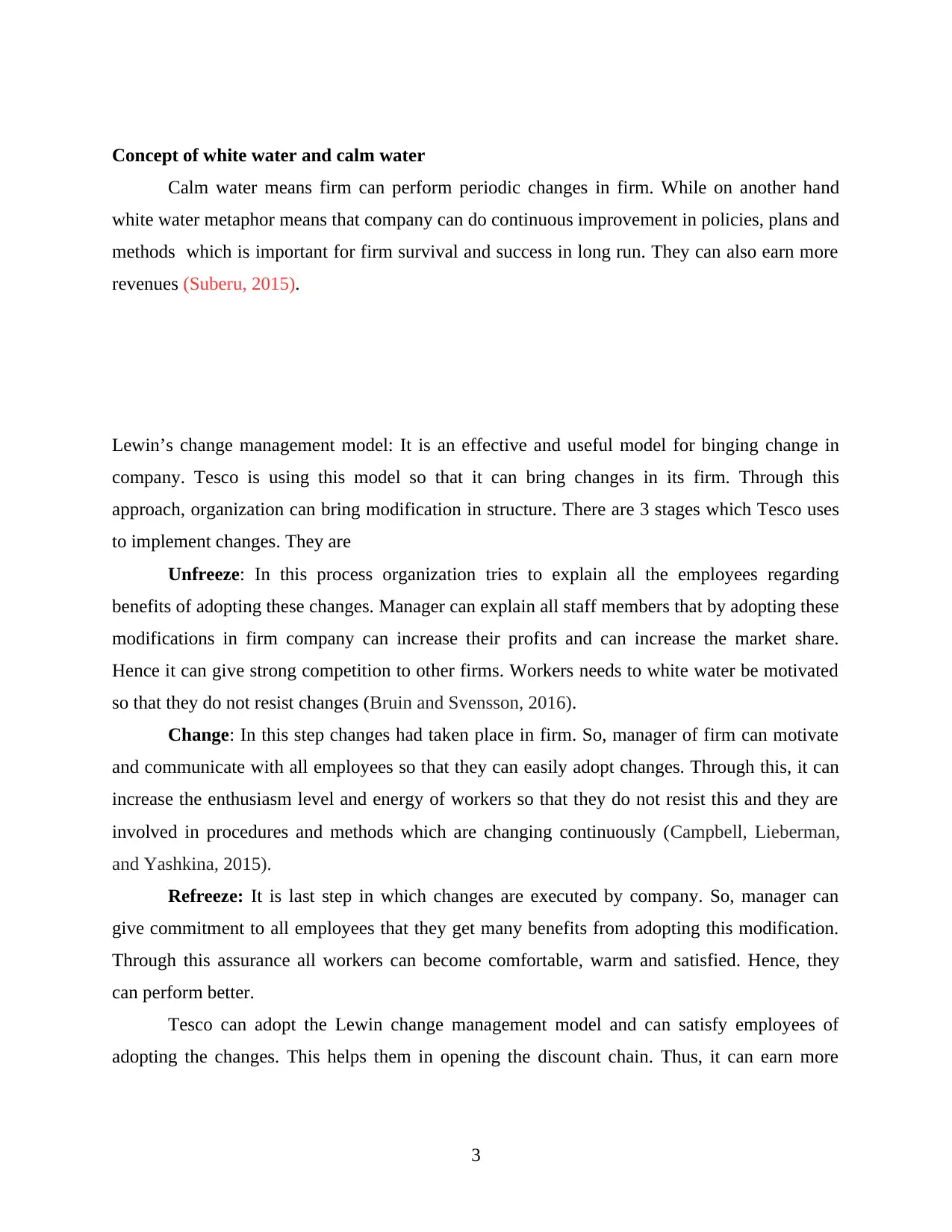
Concept of white water and calm water
Calm water means firm can perform periodic changes in firm. While on another hand
white water metaphor means that company can do continuous improvement in policies, plans and
methods which is important for firm survival and success in long run. They can also earn more
revenues (Suberu, 2015).
Lewin’s change management model: It is an effective and useful model for binging change in
company. Tesco is using this model so that it can bring changes in its firm. Through this
approach, organization can bring modification in structure. There are 3 stages which Tesco uses
to implement changes. They are
Unfreeze: In this process organization tries to explain all the employees regarding
benefits of adopting these changes. Manager can explain all staff members that by adopting these
modifications in firm company can increase their profits and can increase the market share.
Hence it can give strong competition to other firms. Workers needs to white water be motivated
so that they do not resist changes (Bruin and Svensson, 2016).
Change: In this step changes had taken place in firm. So, manager of firm can motivate
and communicate with all employees so that they can easily adopt changes. Through this, it can
increase the enthusiasm level and energy of workers so that they do not resist this and they are
involved in procedures and methods which are changing continuously (Campbell, Lieberman,
and Yashkina, 2015).
Refreeze: It is last step in which changes are executed by company. So, manager can
give commitment to all employees that they get many benefits from adopting this modification.
Through this assurance all workers can become comfortable, warm and satisfied. Hence, they
can perform better.
Tesco can adopt the Lewin change management model and can satisfy employees of
adopting the changes. This helps them in opening the discount chain. Thus, it can earn more
3
Calm water means firm can perform periodic changes in firm. While on another hand
white water metaphor means that company can do continuous improvement in policies, plans and
methods which is important for firm survival and success in long run. They can also earn more
revenues (Suberu, 2015).
Lewin’s change management model: It is an effective and useful model for binging change in
company. Tesco is using this model so that it can bring changes in its firm. Through this
approach, organization can bring modification in structure. There are 3 stages which Tesco uses
to implement changes. They are
Unfreeze: In this process organization tries to explain all the employees regarding
benefits of adopting these changes. Manager can explain all staff members that by adopting these
modifications in firm company can increase their profits and can increase the market share.
Hence it can give strong competition to other firms. Workers needs to white water be motivated
so that they do not resist changes (Bruin and Svensson, 2016).
Change: In this step changes had taken place in firm. So, manager of firm can motivate
and communicate with all employees so that they can easily adopt changes. Through this, it can
increase the enthusiasm level and energy of workers so that they do not resist this and they are
involved in procedures and methods which are changing continuously (Campbell, Lieberman,
and Yashkina, 2015).
Refreeze: It is last step in which changes are executed by company. So, manager can
give commitment to all employees that they get many benefits from adopting this modification.
Through this assurance all workers can become comfortable, warm and satisfied. Hence, they
can perform better.
Tesco can adopt the Lewin change management model and can satisfy employees of
adopting the changes. This helps them in opening the discount chain. Thus, it can earn more
3
Paraphrase This Document
Need a fresh take? Get an instant paraphrase of this document with our AI Paraphraser
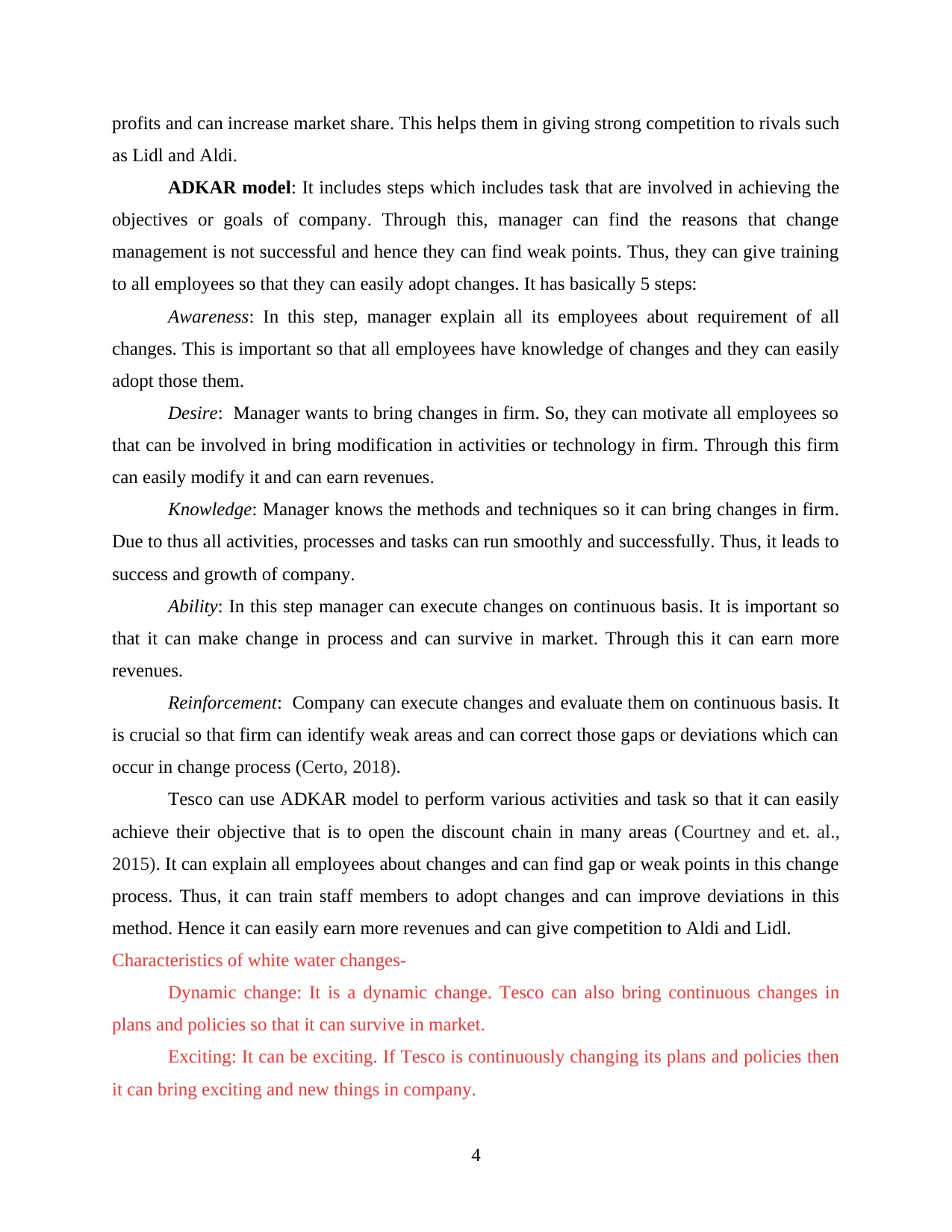
profits and can increase market share. This helps them in giving strong competition to rivals such
as Lidl and Aldi.
ADKAR model: It includes steps which includes task that are involved in achieving the
objectives or goals of company. Through this, manager can find the reasons that change
management is not successful and hence they can find weak points. Thus, they can give training
to all employees so that they can easily adopt changes. It has basically 5 steps:
Awareness: In this step, manager explain all its employees about requirement of all
changes. This is important so that all employees have knowledge of changes and they can easily
adopt those them.
Desire: Manager wants to bring changes in firm. So, they can motivate all employees so
that can be involved in bring modification in activities or technology in firm. Through this firm
can easily modify it and can earn revenues.
Knowledge: Manager knows the methods and techniques so it can bring changes in firm.
Due to thus all activities, processes and tasks can run smoothly and successfully. Thus, it leads to
success and growth of company.
Ability: In this step manager can execute changes on continuous basis. It is important so
that it can make change in process and can survive in market. Through this it can earn more
revenues.
Reinforcement: Company can execute changes and evaluate them on continuous basis. It
is crucial so that firm can identify weak areas and can correct those gaps or deviations which can
occur in change process (Certo, 2018).
Tesco can use ADKAR model to perform various activities and task so that it can easily
achieve their objective that is to open the discount chain in many areas (Courtney and et. al.,
2015). It can explain all employees about changes and can find gap or weak points in this change
process. Thus, it can train staff members to adopt changes and can improve deviations in this
method. Hence it can easily earn more revenues and can give competition to Aldi and Lidl.
Characteristics of white water changes-
Dynamic change: It is a dynamic change. Tesco can also bring continuous changes in
plans and policies so that it can survive in market.
Exciting: It can be exciting. If Tesco is continuously changing its plans and policies then
it can bring exciting and new things in company.
4
as Lidl and Aldi.
ADKAR model: It includes steps which includes task that are involved in achieving the
objectives or goals of company. Through this, manager can find the reasons that change
management is not successful and hence they can find weak points. Thus, they can give training
to all employees so that they can easily adopt changes. It has basically 5 steps:
Awareness: In this step, manager explain all its employees about requirement of all
changes. This is important so that all employees have knowledge of changes and they can easily
adopt those them.
Desire: Manager wants to bring changes in firm. So, they can motivate all employees so
that can be involved in bring modification in activities or technology in firm. Through this firm
can easily modify it and can earn revenues.
Knowledge: Manager knows the methods and techniques so it can bring changes in firm.
Due to thus all activities, processes and tasks can run smoothly and successfully. Thus, it leads to
success and growth of company.
Ability: In this step manager can execute changes on continuous basis. It is important so
that it can make change in process and can survive in market. Through this it can earn more
revenues.
Reinforcement: Company can execute changes and evaluate them on continuous basis. It
is crucial so that firm can identify weak areas and can correct those gaps or deviations which can
occur in change process (Certo, 2018).
Tesco can use ADKAR model to perform various activities and task so that it can easily
achieve their objective that is to open the discount chain in many areas (Courtney and et. al.,
2015). It can explain all employees about changes and can find gap or weak points in this change
process. Thus, it can train staff members to adopt changes and can improve deviations in this
method. Hence it can easily earn more revenues and can give competition to Aldi and Lidl.
Characteristics of white water changes-
Dynamic change: It is a dynamic change. Tesco can also bring continuous changes in
plans and policies so that it can survive in market.
Exciting: It can be exciting. If Tesco is continuously changing its plans and policies then
it can bring exciting and new things in company.
4
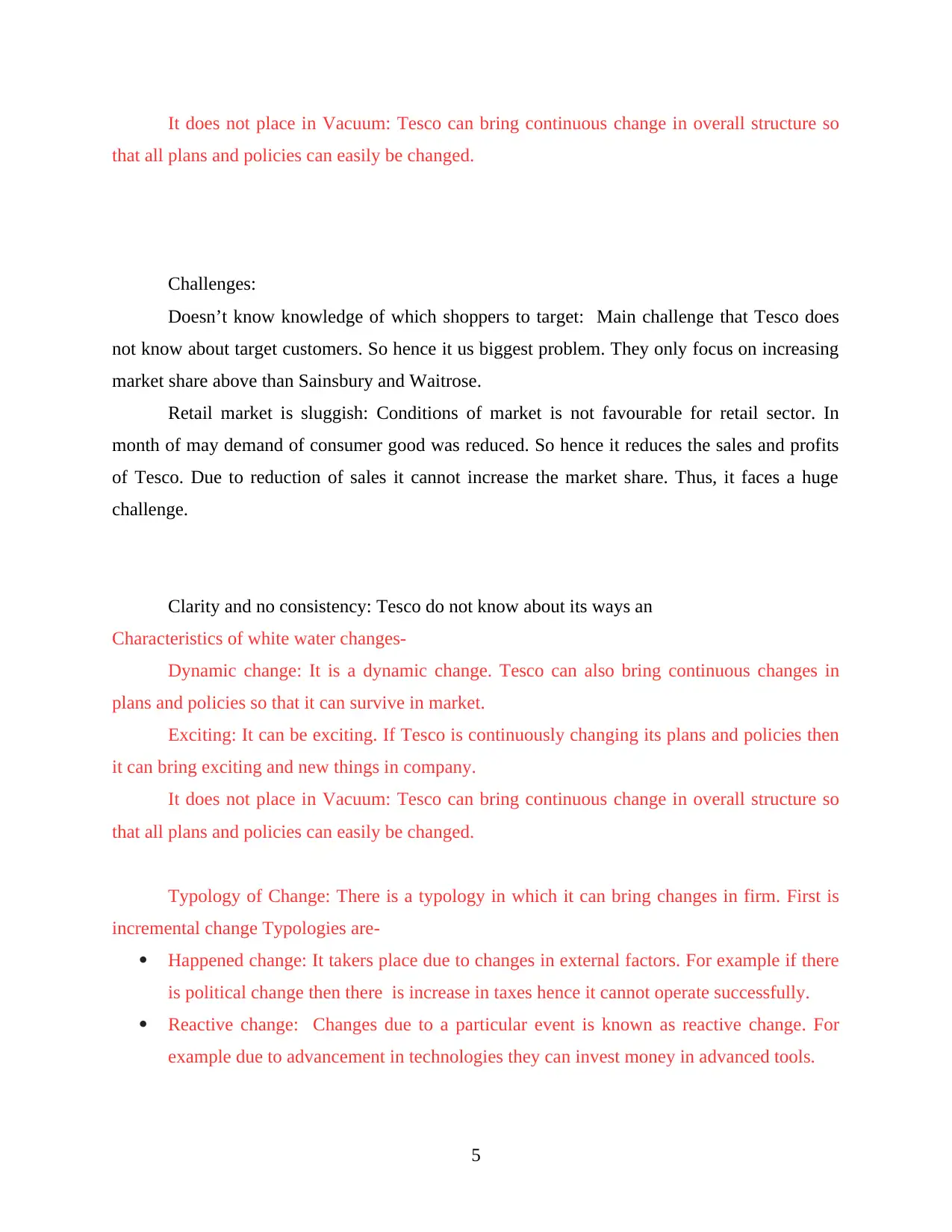
It does not place in Vacuum: Tesco can bring continuous change in overall structure so
that all plans and policies can easily be changed.
Challenges:
Doesn’t know knowledge of which shoppers to target: Main challenge that Tesco does
not know about target customers. So hence it us biggest problem. They only focus on increasing
market share above than Sainsbury and Waitrose.
Retail market is sluggish: Conditions of market is not favourable for retail sector. In
month of may demand of consumer good was reduced. So hence it reduces the sales and profits
of Tesco. Due to reduction of sales it cannot increase the market share. Thus, it faces a huge
challenge.
Clarity and no consistency: Tesco do not know about its ways an
Characteristics of white water changes-
Dynamic change: It is a dynamic change. Tesco can also bring continuous changes in
plans and policies so that it can survive in market.
Exciting: It can be exciting. If Tesco is continuously changing its plans and policies then
it can bring exciting and new things in company.
It does not place in Vacuum: Tesco can bring continuous change in overall structure so
that all plans and policies can easily be changed.
Typology of Change: There is a typology in which it can bring changes in firm. First is
incremental change Typologies are-
Happened change: It takers place due to changes in external factors. For example if there
is political change then there is increase in taxes hence it cannot operate successfully.
Reactive change: Changes due to a particular event is known as reactive change. For
example due to advancement in technologies they can invest money in advanced tools.
5
that all plans and policies can easily be changed.
Challenges:
Doesn’t know knowledge of which shoppers to target: Main challenge that Tesco does
not know about target customers. So hence it us biggest problem. They only focus on increasing
market share above than Sainsbury and Waitrose.
Retail market is sluggish: Conditions of market is not favourable for retail sector. In
month of may demand of consumer good was reduced. So hence it reduces the sales and profits
of Tesco. Due to reduction of sales it cannot increase the market share. Thus, it faces a huge
challenge.
Clarity and no consistency: Tesco do not know about its ways an
Characteristics of white water changes-
Dynamic change: It is a dynamic change. Tesco can also bring continuous changes in
plans and policies so that it can survive in market.
Exciting: It can be exciting. If Tesco is continuously changing its plans and policies then
it can bring exciting and new things in company.
It does not place in Vacuum: Tesco can bring continuous change in overall structure so
that all plans and policies can easily be changed.
Typology of Change: There is a typology in which it can bring changes in firm. First is
incremental change Typologies are-
Happened change: It takers place due to changes in external factors. For example if there
is political change then there is increase in taxes hence it cannot operate successfully.
Reactive change: Changes due to a particular event is known as reactive change. For
example due to advancement in technologies they can invest money in advanced tools.
5
You're viewing a preview
Unlock full access by subscribing today!
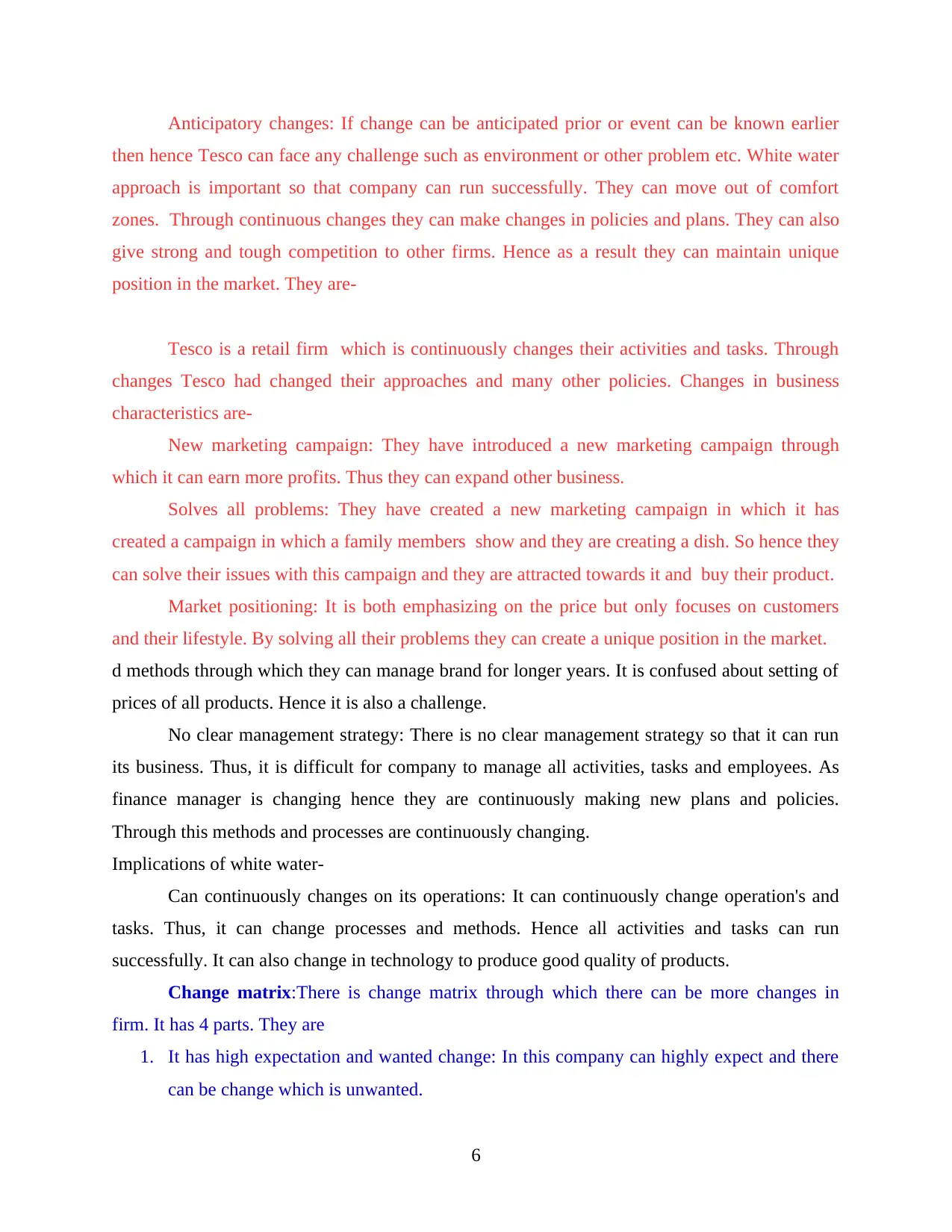
Anticipatory changes: If change can be anticipated prior or event can be known earlier
then hence Tesco can face any challenge such as environment or other problem etc. White water
approach is important so that company can run successfully. They can move out of comfort
zones. Through continuous changes they can make changes in policies and plans. They can also
give strong and tough competition to other firms. Hence as a result they can maintain unique
position in the market. They are-
Tesco is a retail firm which is continuously changes their activities and tasks. Through
changes Tesco had changed their approaches and many other policies. Changes in business
characteristics are-
New marketing campaign: They have introduced a new marketing campaign through
which it can earn more profits. Thus they can expand other business.
Solves all problems: They have created a new marketing campaign in which it has
created a campaign in which a family members show and they are creating a dish. So hence they
can solve their issues with this campaign and they are attracted towards it and buy their product.
Market positioning: It is both emphasizing on the price but only focuses on customers
and their lifestyle. By solving all their problems they can create a unique position in the market.
d methods through which they can manage brand for longer years. It is confused about setting of
prices of all products. Hence it is also a challenge.
No clear management strategy: There is no clear management strategy so that it can run
its business. Thus, it is difficult for company to manage all activities, tasks and employees. As
finance manager is changing hence they are continuously making new plans and policies.
Through this methods and processes are continuously changing.
Implications of white water-
Can continuously changes on its operations: It can continuously change operation's and
tasks. Thus, it can change processes and methods. Hence all activities and tasks can run
successfully. It can also change in technology to produce good quality of products.
Change matrix:There is change matrix through which there can be more changes in
firm. It has 4 parts. They are
1. It has high expectation and wanted change: In this company can highly expect and there
can be change which is unwanted.
6
then hence Tesco can face any challenge such as environment or other problem etc. White water
approach is important so that company can run successfully. They can move out of comfort
zones. Through continuous changes they can make changes in policies and plans. They can also
give strong and tough competition to other firms. Hence as a result they can maintain unique
position in the market. They are-
Tesco is a retail firm which is continuously changes their activities and tasks. Through
changes Tesco had changed their approaches and many other policies. Changes in business
characteristics are-
New marketing campaign: They have introduced a new marketing campaign through
which it can earn more profits. Thus they can expand other business.
Solves all problems: They have created a new marketing campaign in which it has
created a campaign in which a family members show and they are creating a dish. So hence they
can solve their issues with this campaign and they are attracted towards it and buy their product.
Market positioning: It is both emphasizing on the price but only focuses on customers
and their lifestyle. By solving all their problems they can create a unique position in the market.
d methods through which they can manage brand for longer years. It is confused about setting of
prices of all products. Hence it is also a challenge.
No clear management strategy: There is no clear management strategy so that it can run
its business. Thus, it is difficult for company to manage all activities, tasks and employees. As
finance manager is changing hence they are continuously making new plans and policies.
Through this methods and processes are continuously changing.
Implications of white water-
Can continuously changes on its operations: It can continuously change operation's and
tasks. Thus, it can change processes and methods. Hence all activities and tasks can run
successfully. It can also change in technology to produce good quality of products.
Change matrix:There is change matrix through which there can be more changes in
firm. It has 4 parts. They are
1. It has high expectation and wanted change: In this company can highly expect and there
can be change which is unwanted.
6
Paraphrase This Document
Need a fresh take? Get an instant paraphrase of this document with our AI Paraphraser
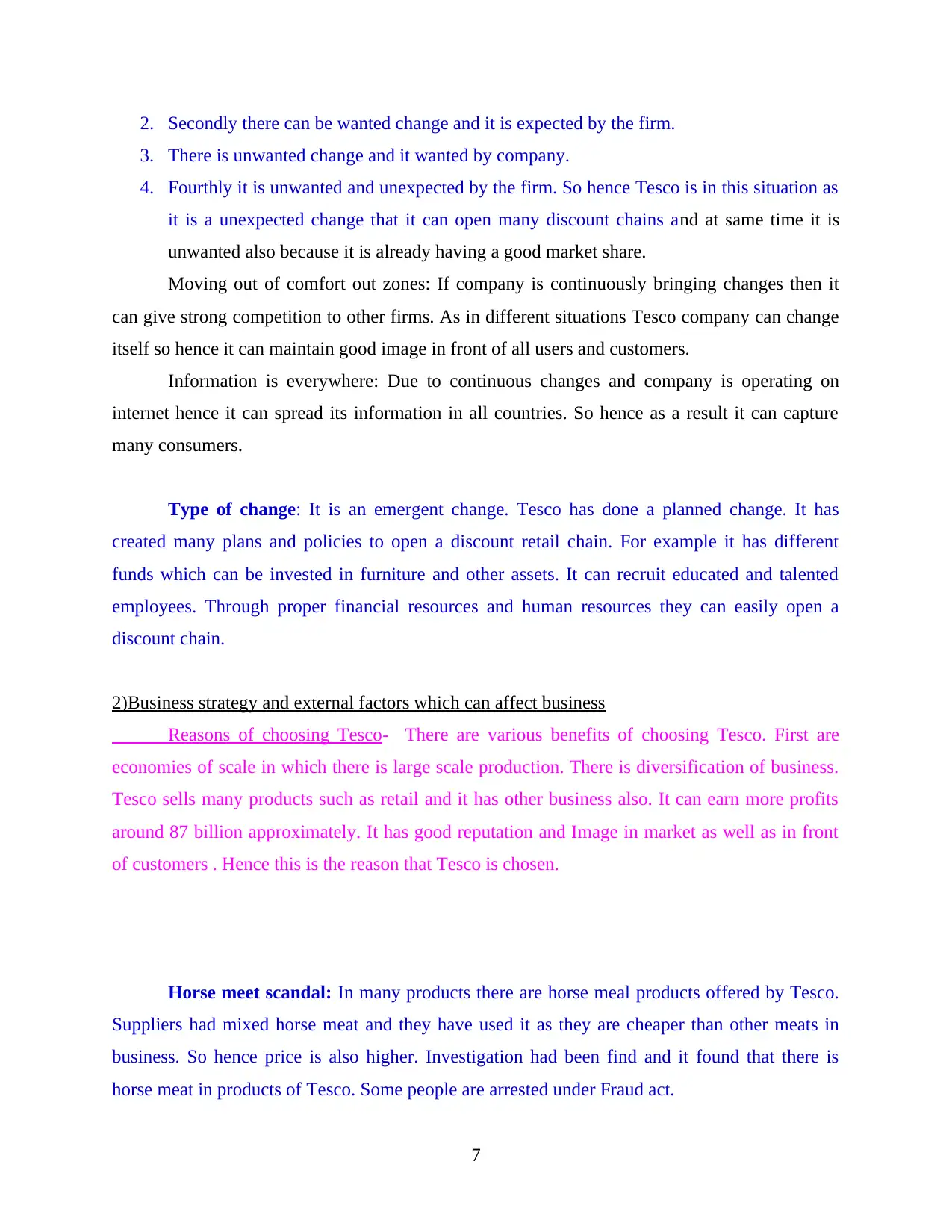
2. Secondly there can be wanted change and it is expected by the firm.
3. There is unwanted change and it wanted by company.
4. Fourthly it is unwanted and unexpected by the firm. So hence Tesco is in this situation as
it is a unexpected change that it can open many discount chains and at same time it is
unwanted also because it is already having a good market share.
Moving out of comfort out zones: If company is continuously bringing changes then it
can give strong competition to other firms. As in different situations Tesco company can change
itself so hence it can maintain good image in front of all users and customers.
Information is everywhere: Due to continuous changes and company is operating on
internet hence it can spread its information in all countries. So hence as a result it can capture
many consumers.
Type of change: It is an emergent change. Tesco has done a planned change. It has
created many plans and policies to open a discount retail chain. For example it has different
funds which can be invested in furniture and other assets. It can recruit educated and talented
employees. Through proper financial resources and human resources they can easily open a
discount chain.
2)Business strategy and external factors which can affect business
Reasons of choosing Tesco- There are various benefits of choosing Tesco. First are
economies of scale in which there is large scale production. There is diversification of business.
Tesco sells many products such as retail and it has other business also. It can earn more profits
around 87 billion approximately. It has good reputation and Image in market as well as in front
of customers . Hence this is the reason that Tesco is chosen.
Horse meet scandal: In many products there are horse meal products offered by Tesco.
Suppliers had mixed horse meat and they have used it as they are cheaper than other meats in
business. So hence price is also higher. Investigation had been find and it found that there is
horse meat in products of Tesco. Some people are arrested under Fraud act.
7
3. There is unwanted change and it wanted by company.
4. Fourthly it is unwanted and unexpected by the firm. So hence Tesco is in this situation as
it is a unexpected change that it can open many discount chains and at same time it is
unwanted also because it is already having a good market share.
Moving out of comfort out zones: If company is continuously bringing changes then it
can give strong competition to other firms. As in different situations Tesco company can change
itself so hence it can maintain good image in front of all users and customers.
Information is everywhere: Due to continuous changes and company is operating on
internet hence it can spread its information in all countries. So hence as a result it can capture
many consumers.
Type of change: It is an emergent change. Tesco has done a planned change. It has
created many plans and policies to open a discount retail chain. For example it has different
funds which can be invested in furniture and other assets. It can recruit educated and talented
employees. Through proper financial resources and human resources they can easily open a
discount chain.
2)Business strategy and external factors which can affect business
Reasons of choosing Tesco- There are various benefits of choosing Tesco. First are
economies of scale in which there is large scale production. There is diversification of business.
Tesco sells many products such as retail and it has other business also. It can earn more profits
around 87 billion approximately. It has good reputation and Image in market as well as in front
of customers . Hence this is the reason that Tesco is chosen.
Horse meet scandal: In many products there are horse meal products offered by Tesco.
Suppliers had mixed horse meat and they have used it as they are cheaper than other meats in
business. So hence price is also higher. Investigation had been find and it found that there is
horse meat in products of Tesco. Some people are arrested under Fraud act.
7
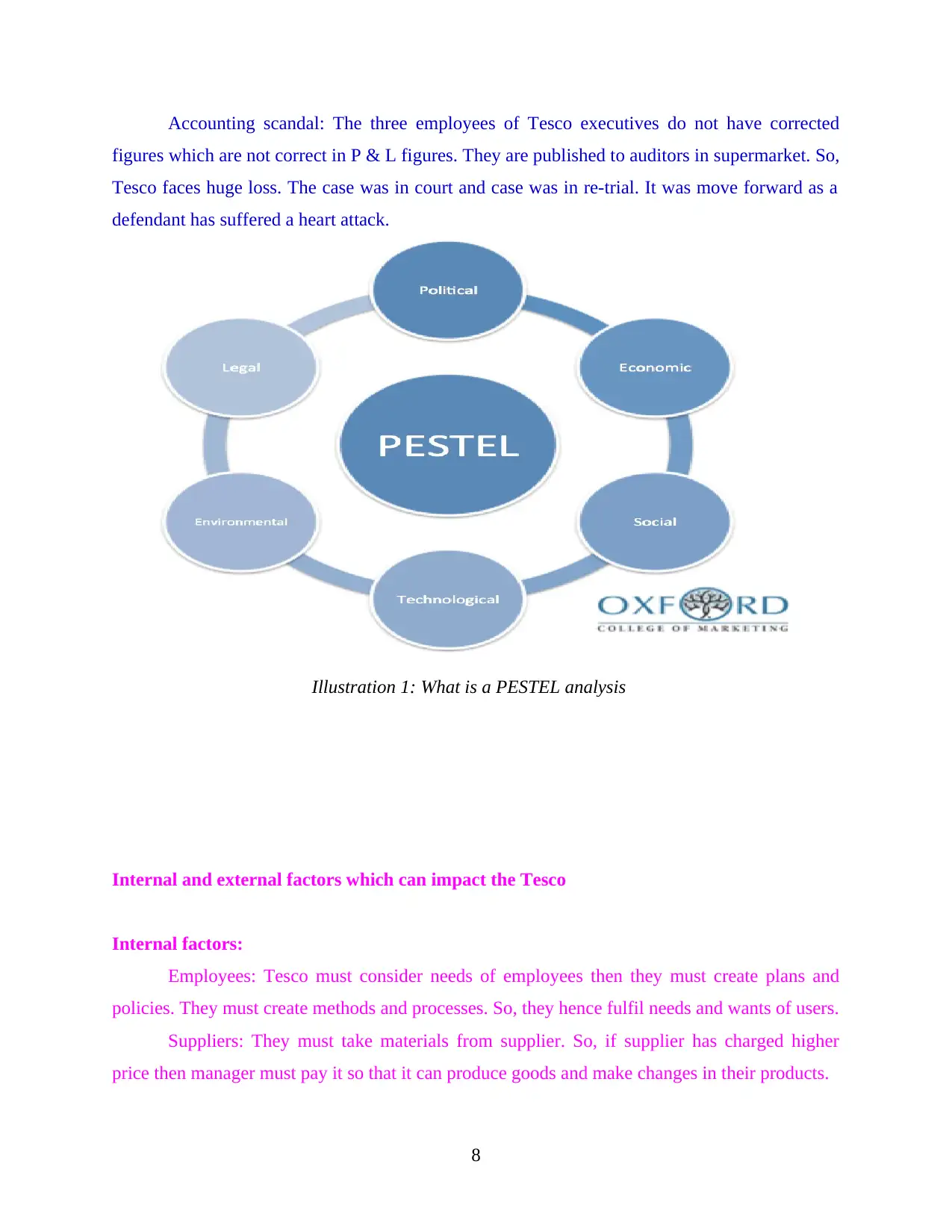
Accounting scandal: The three employees of Tesco executives do not have corrected
figures which are not correct in P & L figures. They are published to auditors in supermarket. So,
Tesco faces huge loss. The case was in court and case was in re-trial. It was move forward as a
defendant has suffered a heart attack.
Internal and external factors which can impact the Tesco
Internal factors:
Employees: Tesco must consider needs of employees then they must create plans and
policies. They must create methods and processes. So, they hence fulfil needs and wants of users.
Suppliers: They must take materials from supplier. So, if supplier has charged higher
price then manager must pay it so that it can produce goods and make changes in their products.
8
Illustration 1: What is a PESTEL analysis
figures which are not correct in P & L figures. They are published to auditors in supermarket. So,
Tesco faces huge loss. The case was in court and case was in re-trial. It was move forward as a
defendant has suffered a heart attack.
Internal and external factors which can impact the Tesco
Internal factors:
Employees: Tesco must consider needs of employees then they must create plans and
policies. They must create methods and processes. So, they hence fulfil needs and wants of users.
Suppliers: They must take materials from supplier. So, if supplier has charged higher
price then manager must pay it so that it can produce goods and make changes in their products.
8
Illustration 1: What is a PESTEL analysis
You're viewing a preview
Unlock full access by subscribing today!
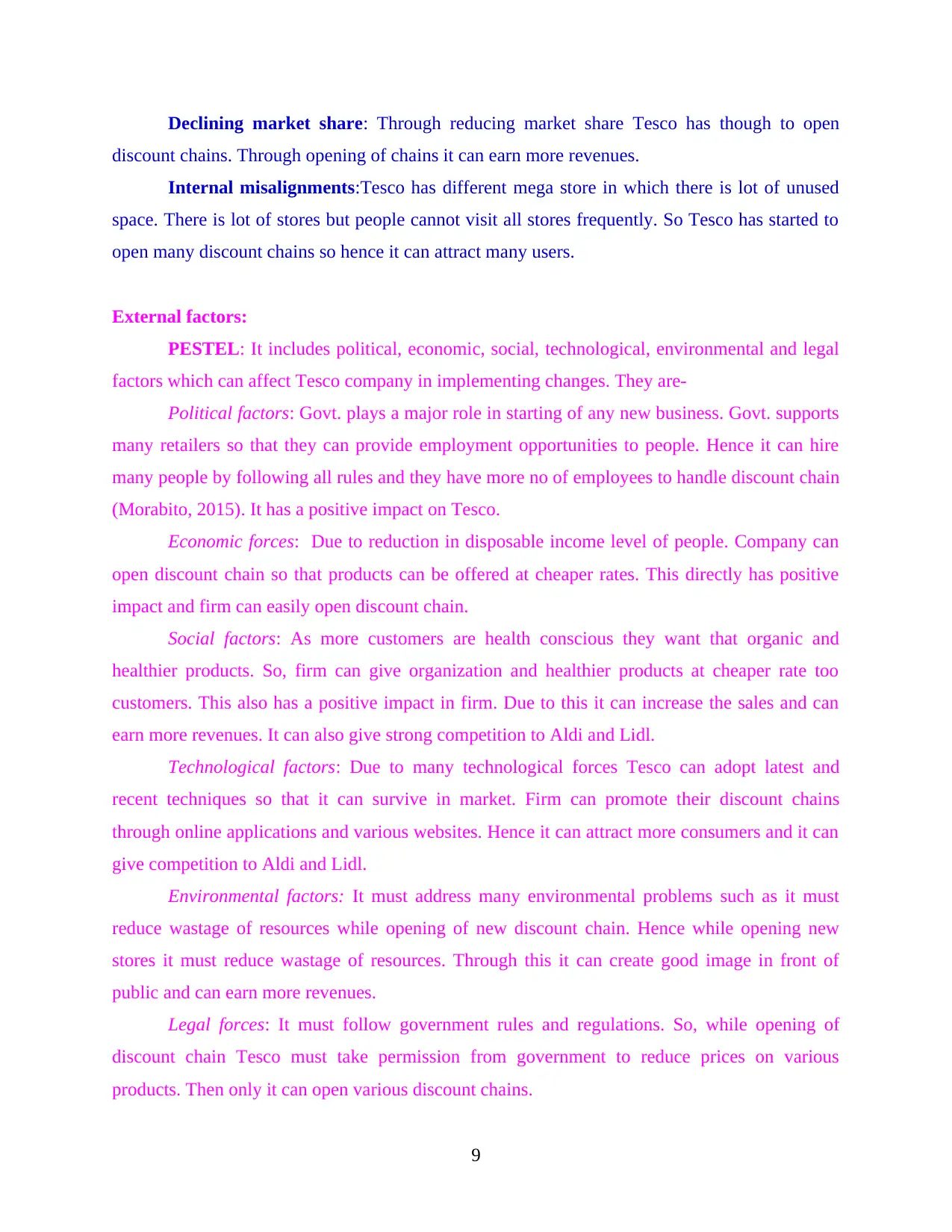
Declining market share: Through reducing market share Tesco has though to open
discount chains. Through opening of chains it can earn more revenues.
Internal misalignments:Tesco has different mega store in which there is lot of unused
space. There is lot of stores but people cannot visit all stores frequently. So Tesco has started to
open many discount chains so hence it can attract many users.
External factors:
PESTEL: It includes political, economic, social, technological, environmental and legal
factors which can affect Tesco company in implementing changes. They are-
Political factors: Govt. plays a major role in starting of any new business. Govt. supports
many retailers so that they can provide employment opportunities to people. Hence it can hire
many people by following all rules and they have more no of employees to handle discount chain
(Morabito, 2015). It has a positive impact on Tesco.
Economic forces: Due to reduction in disposable income level of people. Company can
open discount chain so that products can be offered at cheaper rates. This directly has positive
impact and firm can easily open discount chain.
Social factors: As more customers are health conscious they want that organic and
healthier products. So, firm can give organization and healthier products at cheaper rate too
customers. This also has a positive impact in firm. Due to this it can increase the sales and can
earn more revenues. It can also give strong competition to Aldi and Lidl.
Technological factors: Due to many technological forces Tesco can adopt latest and
recent techniques so that it can survive in market. Firm can promote their discount chains
through online applications and various websites. Hence it can attract more consumers and it can
give competition to Aldi and Lidl.
Environmental factors: It must address many environmental problems such as it must
reduce wastage of resources while opening of new discount chain. Hence while opening new
stores it must reduce wastage of resources. Through this it can create good image in front of
public and can earn more revenues.
Legal forces: It must follow government rules and regulations. So, while opening of
discount chain Tesco must take permission from government to reduce prices on various
products. Then only it can open various discount chains.
9
discount chains. Through opening of chains it can earn more revenues.
Internal misalignments:Tesco has different mega store in which there is lot of unused
space. There is lot of stores but people cannot visit all stores frequently. So Tesco has started to
open many discount chains so hence it can attract many users.
External factors:
PESTEL: It includes political, economic, social, technological, environmental and legal
factors which can affect Tesco company in implementing changes. They are-
Political factors: Govt. plays a major role in starting of any new business. Govt. supports
many retailers so that they can provide employment opportunities to people. Hence it can hire
many people by following all rules and they have more no of employees to handle discount chain
(Morabito, 2015). It has a positive impact on Tesco.
Economic forces: Due to reduction in disposable income level of people. Company can
open discount chain so that products can be offered at cheaper rates. This directly has positive
impact and firm can easily open discount chain.
Social factors: As more customers are health conscious they want that organic and
healthier products. So, firm can give organization and healthier products at cheaper rate too
customers. This also has a positive impact in firm. Due to this it can increase the sales and can
earn more revenues. It can also give strong competition to Aldi and Lidl.
Technological factors: Due to many technological forces Tesco can adopt latest and
recent techniques so that it can survive in market. Firm can promote their discount chains
through online applications and various websites. Hence it can attract more consumers and it can
give competition to Aldi and Lidl.
Environmental factors: It must address many environmental problems such as it must
reduce wastage of resources while opening of new discount chain. Hence while opening new
stores it must reduce wastage of resources. Through this it can create good image in front of
public and can earn more revenues.
Legal forces: It must follow government rules and regulations. So, while opening of
discount chain Tesco must take permission from government to reduce prices on various
products. Then only it can open various discount chains.
9
Paraphrase This Document
Need a fresh take? Get an instant paraphrase of this document with our AI Paraphraser
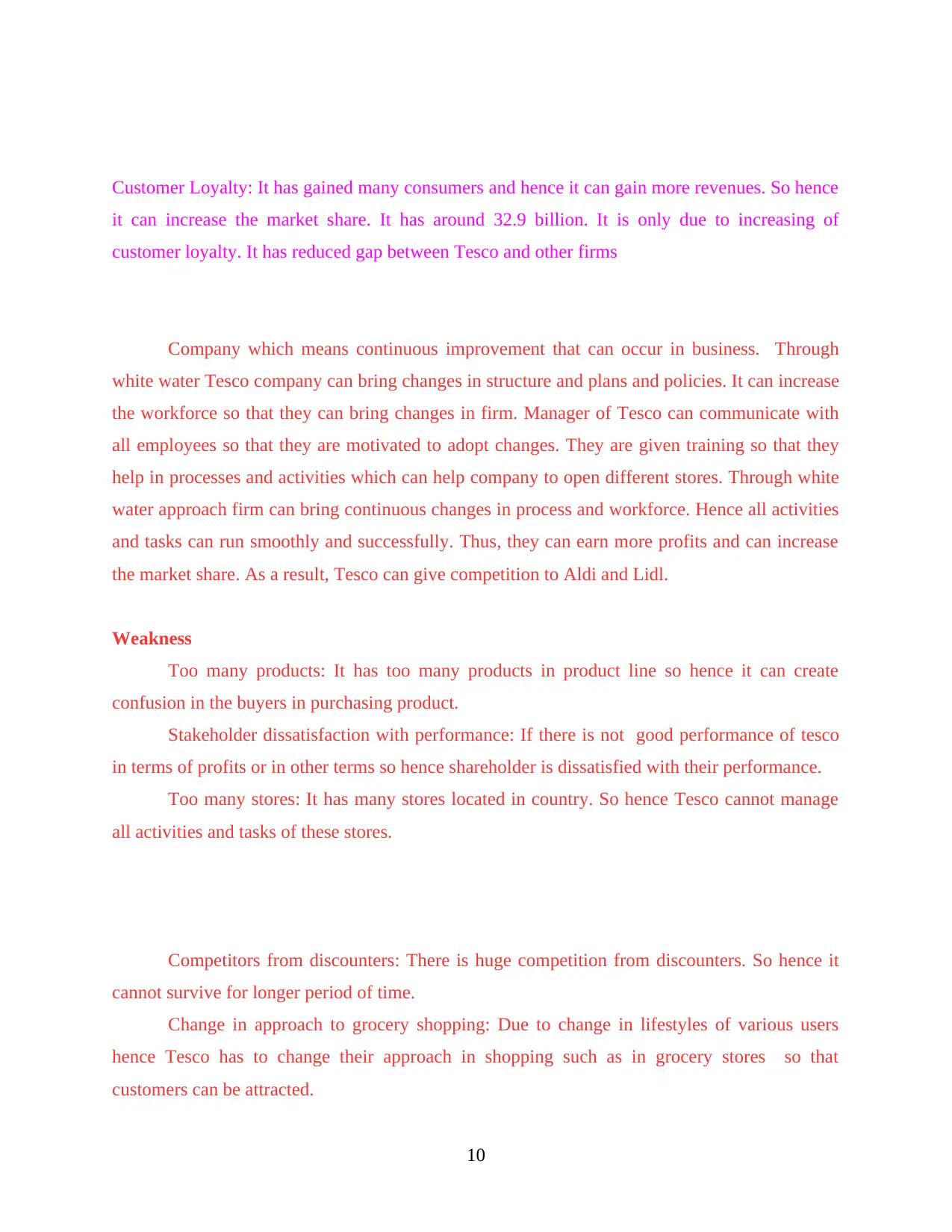
Customer Loyalty: It has gained many consumers and hence it can gain more revenues. So hence
it can increase the market share. It has around 32.9 billion. It is only due to increasing of
customer loyalty. It has reduced gap between Tesco and other firms
Company which means continuous improvement that can occur in business. Through
white water Tesco company can bring changes in structure and plans and policies. It can increase
the workforce so that they can bring changes in firm. Manager of Tesco can communicate with
all employees so that they are motivated to adopt changes. They are given training so that they
help in processes and activities which can help company to open different stores. Through white
water approach firm can bring continuous changes in process and workforce. Hence all activities
and tasks can run smoothly and successfully. Thus, they can earn more profits and can increase
the market share. As a result, Tesco can give competition to Aldi and Lidl.
Weakness
Too many products: It has too many products in product line so hence it can create
confusion in the buyers in purchasing product.
Stakeholder dissatisfaction with performance: If there is not good performance of tesco
in terms of profits or in other terms so hence shareholder is dissatisfied with their performance.
Too many stores: It has many stores located in country. So hence Tesco cannot manage
all activities and tasks of these stores.
Competitors from discounters: There is huge competition from discounters. So hence it
cannot survive for longer period of time.
Change in approach to grocery shopping: Due to change in lifestyles of various users
hence Tesco has to change their approach in shopping such as in grocery stores so that
customers can be attracted.
10
it can increase the market share. It has around 32.9 billion. It is only due to increasing of
customer loyalty. It has reduced gap between Tesco and other firms
Company which means continuous improvement that can occur in business. Through
white water Tesco company can bring changes in structure and plans and policies. It can increase
the workforce so that they can bring changes in firm. Manager of Tesco can communicate with
all employees so that they are motivated to adopt changes. They are given training so that they
help in processes and activities which can help company to open different stores. Through white
water approach firm can bring continuous changes in process and workforce. Hence all activities
and tasks can run smoothly and successfully. Thus, they can earn more profits and can increase
the market share. As a result, Tesco can give competition to Aldi and Lidl.
Weakness
Too many products: It has too many products in product line so hence it can create
confusion in the buyers in purchasing product.
Stakeholder dissatisfaction with performance: If there is not good performance of tesco
in terms of profits or in other terms so hence shareholder is dissatisfied with their performance.
Too many stores: It has many stores located in country. So hence Tesco cannot manage
all activities and tasks of these stores.
Competitors from discounters: There is huge competition from discounters. So hence it
cannot survive for longer period of time.
Change in approach to grocery shopping: Due to change in lifestyles of various users
hence Tesco has to change their approach in shopping such as in grocery stores so that
customers can be attracted.
10
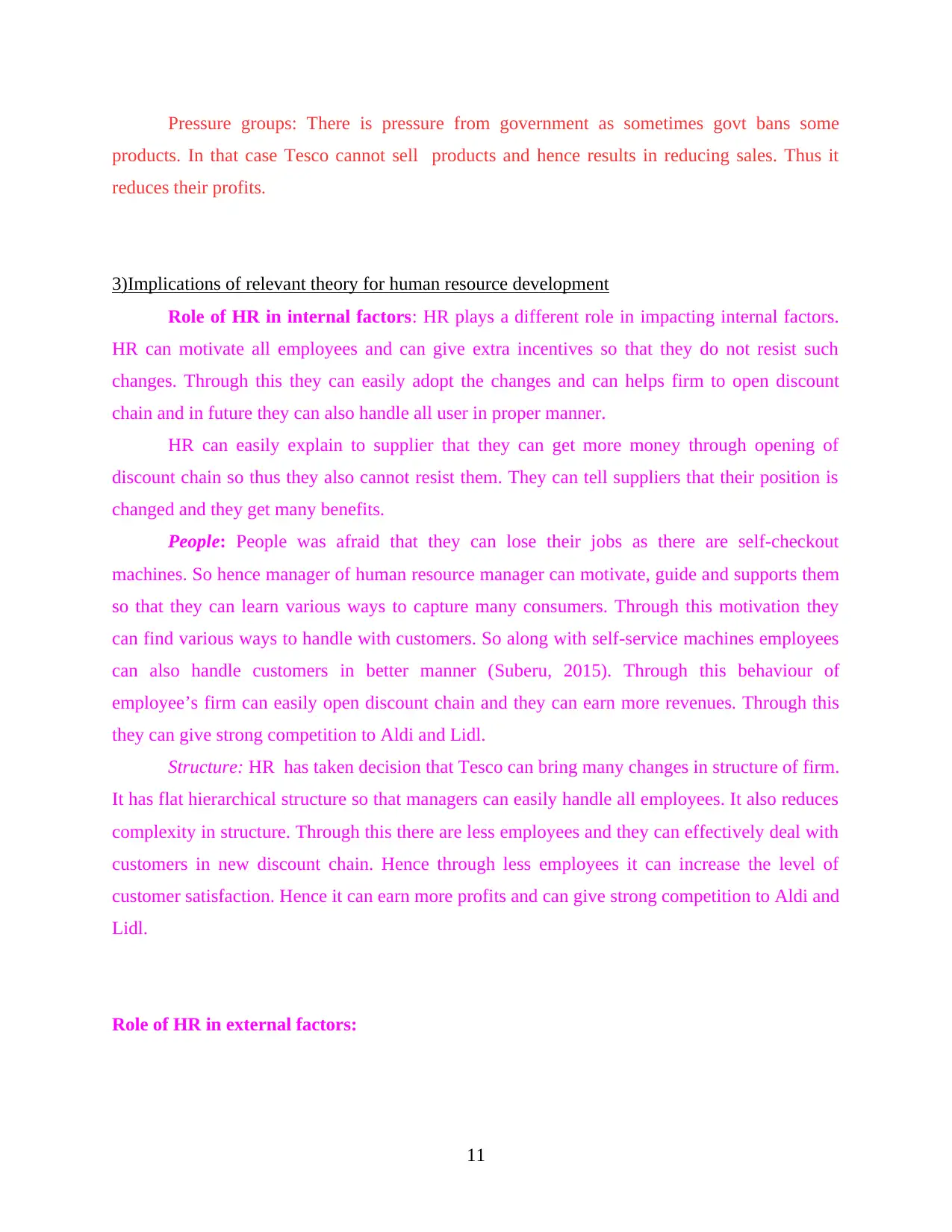
Pressure groups: There is pressure from government as sometimes govt bans some
products. In that case Tesco cannot sell products and hence results in reducing sales. Thus it
reduces their profits.
3)Implications of relevant theory for human resource development
Role of HR in internal factors: HR plays a different role in impacting internal factors.
HR can motivate all employees and can give extra incentives so that they do not resist such
changes. Through this they can easily adopt the changes and can helps firm to open discount
chain and in future they can also handle all user in proper manner.
HR can easily explain to supplier that they can get more money through opening of
discount chain so thus they also cannot resist them. They can tell suppliers that their position is
changed and they get many benefits.
People: People was afraid that they can lose their jobs as there are self-checkout
machines. So hence manager of human resource manager can motivate, guide and supports them
so that they can learn various ways to capture many consumers. Through this motivation they
can find various ways to handle with customers. So along with self-service machines employees
can also handle customers in better manner (Suberu, 2015). Through this behaviour of
employee’s firm can easily open discount chain and they can earn more revenues. Through this
they can give strong competition to Aldi and Lidl.
Structure: HR has taken decision that Tesco can bring many changes in structure of firm.
It has flat hierarchical structure so that managers can easily handle all employees. It also reduces
complexity in structure. Through this there are less employees and they can effectively deal with
customers in new discount chain. Hence through less employees it can increase the level of
customer satisfaction. Hence it can earn more profits and can give strong competition to Aldi and
Lidl.
Role of HR in external factors:
11
products. In that case Tesco cannot sell products and hence results in reducing sales. Thus it
reduces their profits.
3)Implications of relevant theory for human resource development
Role of HR in internal factors: HR plays a different role in impacting internal factors.
HR can motivate all employees and can give extra incentives so that they do not resist such
changes. Through this they can easily adopt the changes and can helps firm to open discount
chain and in future they can also handle all user in proper manner.
HR can easily explain to supplier that they can get more money through opening of
discount chain so thus they also cannot resist them. They can tell suppliers that their position is
changed and they get many benefits.
People: People was afraid that they can lose their jobs as there are self-checkout
machines. So hence manager of human resource manager can motivate, guide and supports them
so that they can learn various ways to capture many consumers. Through this motivation they
can find various ways to handle with customers. So along with self-service machines employees
can also handle customers in better manner (Suberu, 2015). Through this behaviour of
employee’s firm can easily open discount chain and they can earn more revenues. Through this
they can give strong competition to Aldi and Lidl.
Structure: HR has taken decision that Tesco can bring many changes in structure of firm.
It has flat hierarchical structure so that managers can easily handle all employees. It also reduces
complexity in structure. Through this there are less employees and they can effectively deal with
customers in new discount chain. Hence through less employees it can increase the level of
customer satisfaction. Hence it can earn more profits and can give strong competition to Aldi and
Lidl.
Role of HR in external factors:
11
You're viewing a preview
Unlock full access by subscribing today!
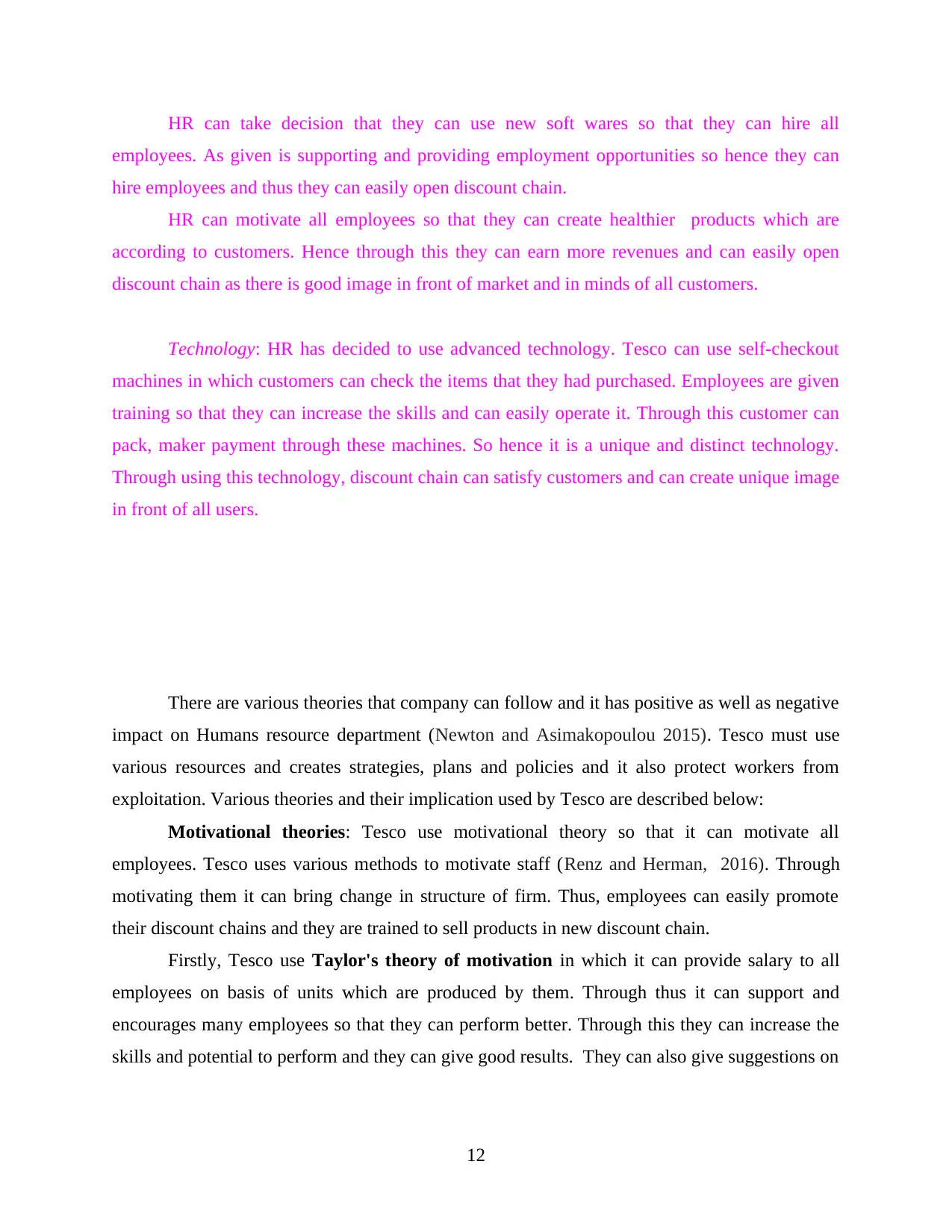
HR can take decision that they can use new soft wares so that they can hire all
employees. As given is supporting and providing employment opportunities so hence they can
hire employees and thus they can easily open discount chain.
HR can motivate all employees so that they can create healthier products which are
according to customers. Hence through this they can earn more revenues and can easily open
discount chain as there is good image in front of market and in minds of all customers.
Technology: HR has decided to use advanced technology. Tesco can use self-checkout
machines in which customers can check the items that they had purchased. Employees are given
training so that they can increase the skills and can easily operate it. Through this customer can
pack, maker payment through these machines. So hence it is a unique and distinct technology.
Through using this technology, discount chain can satisfy customers and can create unique image
in front of all users.
There are various theories that company can follow and it has positive as well as negative
impact on Humans resource department (Newton and Asimakopoulou 2015). Tesco must use
various resources and creates strategies, plans and policies and it also protect workers from
exploitation. Various theories and their implication used by Tesco are described below:
Motivational theories: Tesco use motivational theory so that it can motivate all
employees. Tesco uses various methods to motivate staff (Renz and Herman, 2016). Through
motivating them it can bring change in structure of firm. Thus, employees can easily promote
their discount chains and they are trained to sell products in new discount chain.
Firstly, Tesco use Taylor's theory of motivation in which it can provide salary to all
employees on basis of units which are produced by them. Through thus it can support and
encourages many employees so that they can perform better. Through this they can increase the
skills and potential to perform and they can give good results. They can also give suggestions on
12
employees. As given is supporting and providing employment opportunities so hence they can
hire employees and thus they can easily open discount chain.
HR can motivate all employees so that they can create healthier products which are
according to customers. Hence through this they can earn more revenues and can easily open
discount chain as there is good image in front of market and in minds of all customers.
Technology: HR has decided to use advanced technology. Tesco can use self-checkout
machines in which customers can check the items that they had purchased. Employees are given
training so that they can increase the skills and can easily operate it. Through this customer can
pack, maker payment through these machines. So hence it is a unique and distinct technology.
Through using this technology, discount chain can satisfy customers and can create unique image
in front of all users.
There are various theories that company can follow and it has positive as well as negative
impact on Humans resource department (Newton and Asimakopoulou 2015). Tesco must use
various resources and creates strategies, plans and policies and it also protect workers from
exploitation. Various theories and their implication used by Tesco are described below:
Motivational theories: Tesco use motivational theory so that it can motivate all
employees. Tesco uses various methods to motivate staff (Renz and Herman, 2016). Through
motivating them it can bring change in structure of firm. Thus, employees can easily promote
their discount chains and they are trained to sell products in new discount chain.
Firstly, Tesco use Taylor's theory of motivation in which it can provide salary to all
employees on basis of units which are produced by them. Through thus it can support and
encourages many employees so that they can perform better. Through this they can increase the
skills and potential to perform and they can give good results. They can also give suggestions on
12
Paraphrase This Document
Need a fresh take? Get an instant paraphrase of this document with our AI Paraphraser
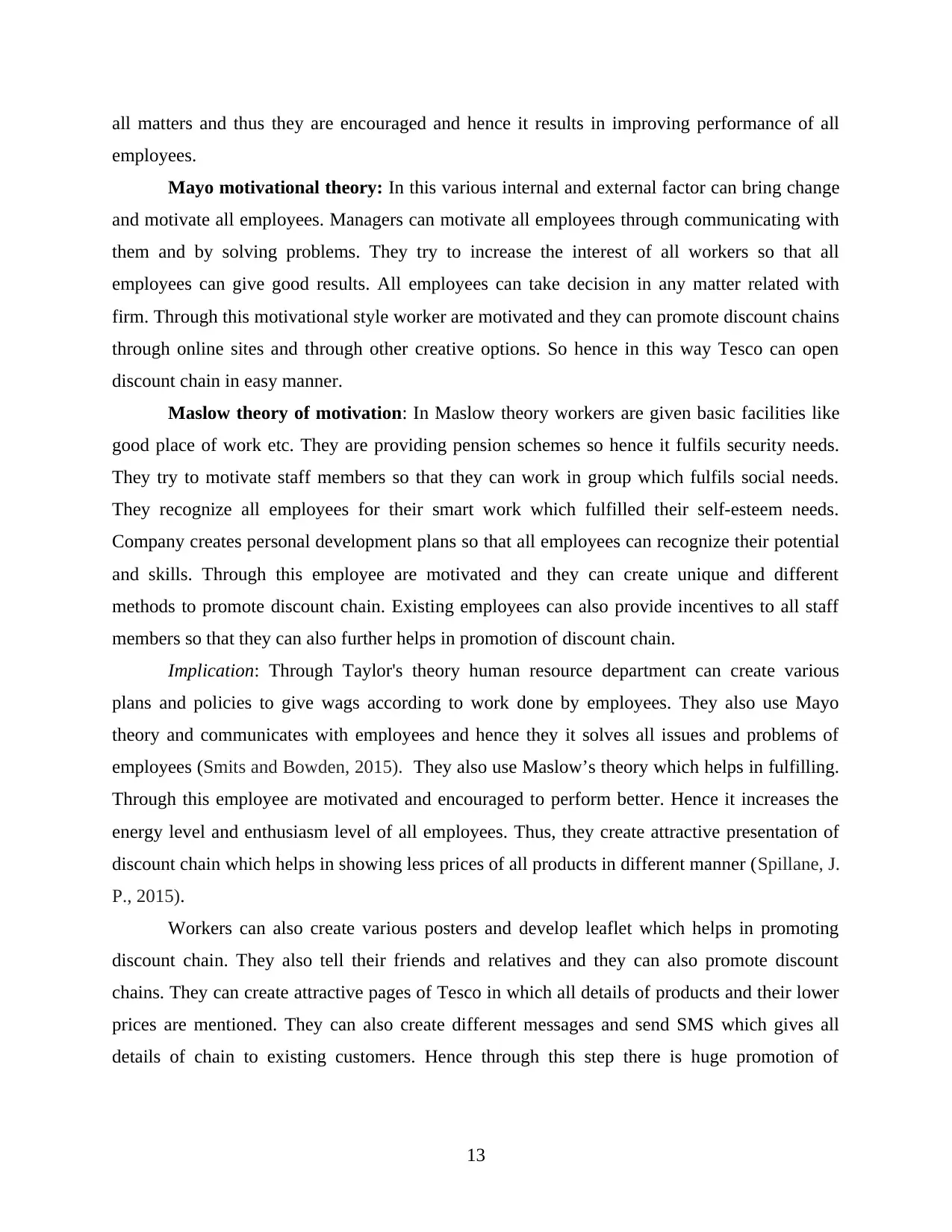
all matters and thus they are encouraged and hence it results in improving performance of all
employees.
Mayo motivational theory: In this various internal and external factor can bring change
and motivate all employees. Managers can motivate all employees through communicating with
them and by solving problems. They try to increase the interest of all workers so that all
employees can give good results. All employees can take decision in any matter related with
firm. Through this motivational style worker are motivated and they can promote discount chains
through online sites and through other creative options. So hence in this way Tesco can open
discount chain in easy manner.
Maslow theory of motivation: In Maslow theory workers are given basic facilities like
good place of work etc. They are providing pension schemes so hence it fulfils security needs.
They try to motivate staff members so that they can work in group which fulfils social needs.
They recognize all employees for their smart work which fulfilled their self-esteem needs.
Company creates personal development plans so that all employees can recognize their potential
and skills. Through this employee are motivated and they can create unique and different
methods to promote discount chain. Existing employees can also provide incentives to all staff
members so that they can also further helps in promotion of discount chain.
Implication: Through Taylor's theory human resource department can create various
plans and policies to give wags according to work done by employees. They also use Mayo
theory and communicates with employees and hence they it solves all issues and problems of
employees (Smits and Bowden, 2015). They also use Maslow’s theory which helps in fulfilling.
Through this employee are motivated and encouraged to perform better. Hence it increases the
energy level and enthusiasm level of all employees. Thus, they create attractive presentation of
discount chain which helps in showing less prices of all products in different manner (Spillane, J.
P., 2015).
Workers can also create various posters and develop leaflet which helps in promoting
discount chain. They also tell their friends and relatives and they can also promote discount
chains. They can create attractive pages of Tesco in which all details of products and their lower
prices are mentioned. They can also create different messages and send SMS which gives all
details of chain to existing customers. Hence through this step there is huge promotion of
13
employees.
Mayo motivational theory: In this various internal and external factor can bring change
and motivate all employees. Managers can motivate all employees through communicating with
them and by solving problems. They try to increase the interest of all workers so that all
employees can give good results. All employees can take decision in any matter related with
firm. Through this motivational style worker are motivated and they can promote discount chains
through online sites and through other creative options. So hence in this way Tesco can open
discount chain in easy manner.
Maslow theory of motivation: In Maslow theory workers are given basic facilities like
good place of work etc. They are providing pension schemes so hence it fulfils security needs.
They try to motivate staff members so that they can work in group which fulfils social needs.
They recognize all employees for their smart work which fulfilled their self-esteem needs.
Company creates personal development plans so that all employees can recognize their potential
and skills. Through this employee are motivated and they can create unique and different
methods to promote discount chain. Existing employees can also provide incentives to all staff
members so that they can also further helps in promotion of discount chain.
Implication: Through Taylor's theory human resource department can create various
plans and policies to give wags according to work done by employees. They also use Mayo
theory and communicates with employees and hence they it solves all issues and problems of
employees (Smits and Bowden, 2015). They also use Maslow’s theory which helps in fulfilling.
Through this employee are motivated and encouraged to perform better. Hence it increases the
energy level and enthusiasm level of all employees. Thus, they create attractive presentation of
discount chain which helps in showing less prices of all products in different manner (Spillane, J.
P., 2015).
Workers can also create various posters and develop leaflet which helps in promoting
discount chain. They also tell their friends and relatives and they can also promote discount
chains. They can create attractive pages of Tesco in which all details of products and their lower
prices are mentioned. They can also create different messages and send SMS which gives all
details of chain to existing customers. Hence through this step there is huge promotion of
13
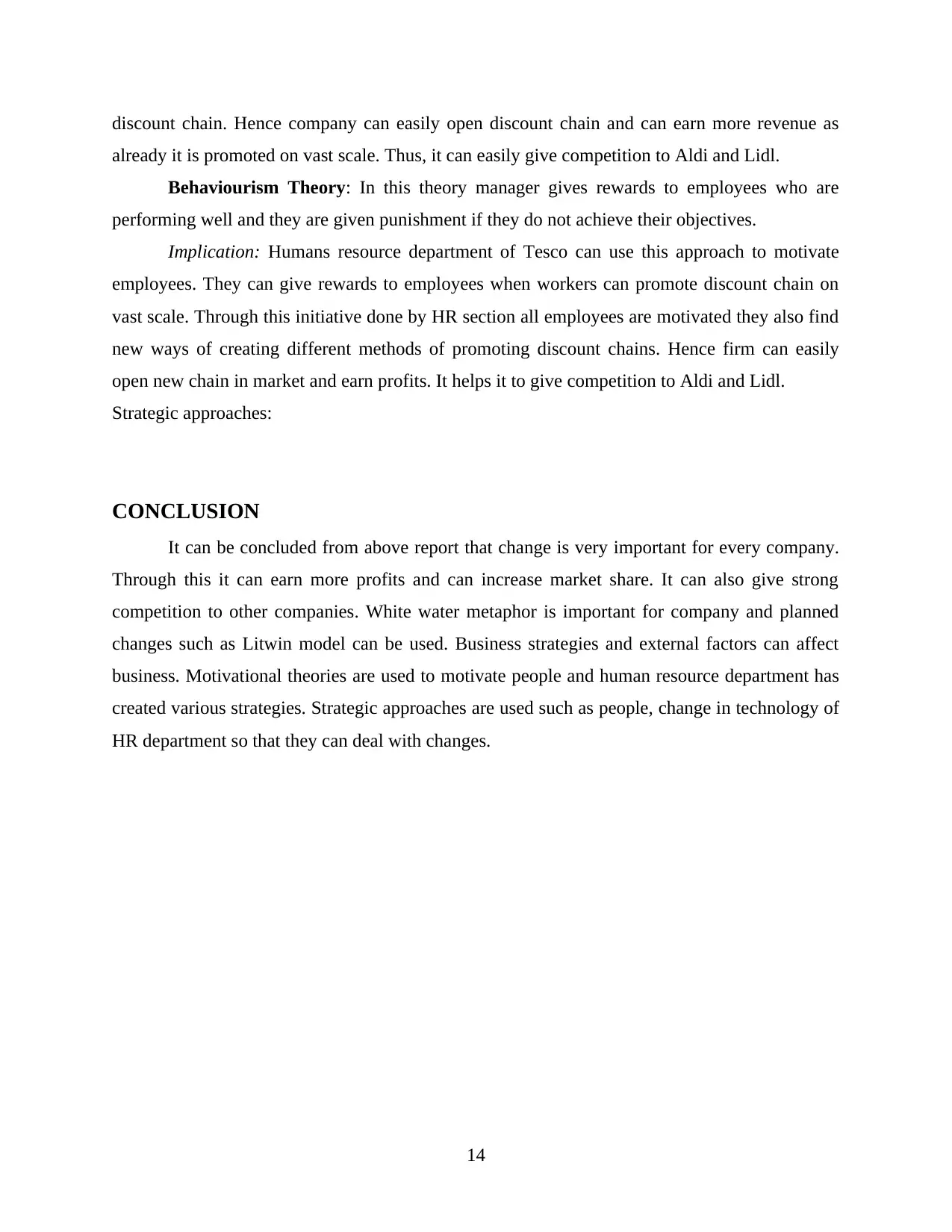
discount chain. Hence company can easily open discount chain and can earn more revenue as
already it is promoted on vast scale. Thus, it can easily give competition to Aldi and Lidl.
Behaviourism Theory: In this theory manager gives rewards to employees who are
performing well and they are given punishment if they do not achieve their objectives.
Implication: Humans resource department of Tesco can use this approach to motivate
employees. They can give rewards to employees when workers can promote discount chain on
vast scale. Through this initiative done by HR section all employees are motivated they also find
new ways of creating different methods of promoting discount chains. Hence firm can easily
open new chain in market and earn profits. It helps it to give competition to Aldi and Lidl.
Strategic approaches:
CONCLUSION
It can be concluded from above report that change is very important for every company.
Through this it can earn more profits and can increase market share. It can also give strong
competition to other companies. White water metaphor is important for company and planned
changes such as Litwin model can be used. Business strategies and external factors can affect
business. Motivational theories are used to motivate people and human resource department has
created various strategies. Strategic approaches are used such as people, change in technology of
HR department so that they can deal with changes.
14
already it is promoted on vast scale. Thus, it can easily give competition to Aldi and Lidl.
Behaviourism Theory: In this theory manager gives rewards to employees who are
performing well and they are given punishment if they do not achieve their objectives.
Implication: Humans resource department of Tesco can use this approach to motivate
employees. They can give rewards to employees when workers can promote discount chain on
vast scale. Through this initiative done by HR section all employees are motivated they also find
new ways of creating different methods of promoting discount chains. Hence firm can easily
open new chain in market and earn profits. It helps it to give competition to Aldi and Lidl.
Strategic approaches:
CONCLUSION
It can be concluded from above report that change is very important for every company.
Through this it can earn more profits and can increase market share. It can also give strong
competition to other companies. White water metaphor is important for company and planned
changes such as Litwin model can be used. Business strategies and external factors can affect
business. Motivational theories are used to motivate people and human resource department has
created various strategies. Strategic approaches are used such as people, change in technology of
HR department so that they can deal with changes.
14
You're viewing a preview
Unlock full access by subscribing today!
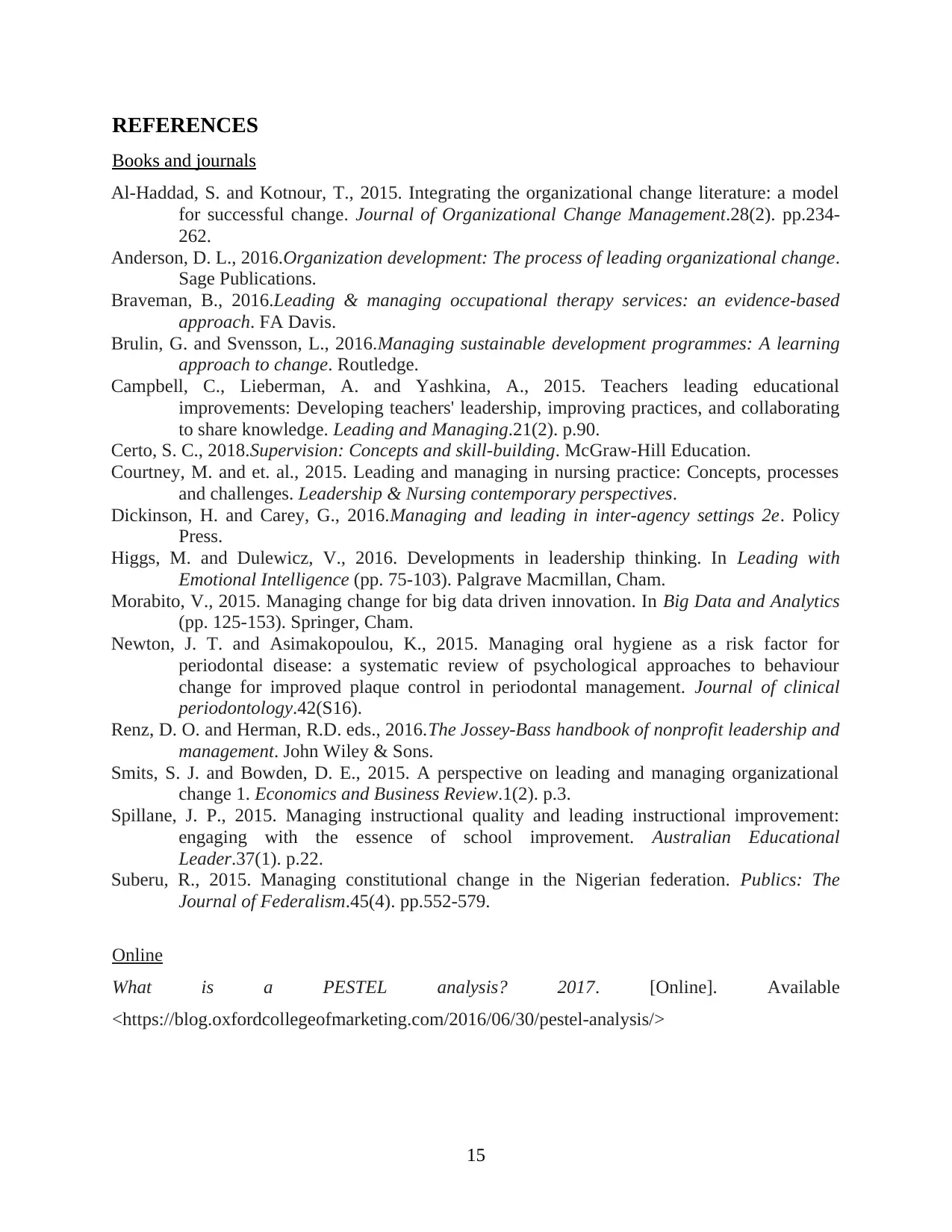
REFERENCES
Books and journals
Al-Haddad, S. and Kotnour, T., 2015. Integrating the organizational change literature: a model
for successful change. Journal of Organizational Change Management.28(2). pp.234-
262.
Anderson, D. L., 2016.Organization development: The process of leading organizational change.
Sage Publications.
Braveman, B., 2016.Leading & managing occupational therapy services: an evidence-based
approach. FA Davis.
Brulin, G. and Svensson, L., 2016.Managing sustainable development programmes: A learning
approach to change. Routledge.
Campbell, C., Lieberman, A. and Yashkina, A., 2015. Teachers leading educational
improvements: Developing teachers' leadership, improving practices, and collaborating
to share knowledge. Leading and Managing.21(2). p.90.
Certo, S. C., 2018.Supervision: Concepts and skill-building. McGraw-Hill Education.
Courtney, M. and et. al., 2015. Leading and managing in nursing practice: Concepts, processes
and challenges. Leadership & Nursing contemporary perspectives.
Dickinson, H. and Carey, G., 2016.Managing and leading in inter-agency settings 2e. Policy
Press.
Higgs, M. and Dulewicz, V., 2016. Developments in leadership thinking. In Leading with
Emotional Intelligence (pp. 75-103). Palgrave Macmillan, Cham.
Morabito, V., 2015. Managing change for big data driven innovation. In Big Data and Analytics
(pp. 125-153). Springer, Cham.
Newton, J. T. and Asimakopoulou, K., 2015. Managing oral hygiene as a risk factor for
periodontal disease: a systematic review of psychological approaches to behaviour
change for improved plaque control in periodontal management. Journal of clinical
periodontology.42(S16).
Renz, D. O. and Herman, R.D. eds., 2016.The Jossey-Bass handbook of nonprofit leadership and
management. John Wiley & Sons.
Smits, S. J. and Bowden, D. E., 2015. A perspective on leading and managing organizational
change 1. Economics and Business Review.1(2). p.3.
Spillane, J. P., 2015. Managing instructional quality and leading instructional improvement:
engaging with the essence of school improvement. Australian Educational
Leader.37(1). p.22.
Suberu, R., 2015. Managing constitutional change in the Nigerian federation. Publics: The
Journal of Federalism.45(4). pp.552-579.
Online
What is a PESTEL analysis? 2017. [Online]. Available
<https://blog.oxfordcollegeofmarketing.com/2016/06/30/pestel-analysis/>
15
Books and journals
Al-Haddad, S. and Kotnour, T., 2015. Integrating the organizational change literature: a model
for successful change. Journal of Organizational Change Management.28(2). pp.234-
262.
Anderson, D. L., 2016.Organization development: The process of leading organizational change.
Sage Publications.
Braveman, B., 2016.Leading & managing occupational therapy services: an evidence-based
approach. FA Davis.
Brulin, G. and Svensson, L., 2016.Managing sustainable development programmes: A learning
approach to change. Routledge.
Campbell, C., Lieberman, A. and Yashkina, A., 2015. Teachers leading educational
improvements: Developing teachers' leadership, improving practices, and collaborating
to share knowledge. Leading and Managing.21(2). p.90.
Certo, S. C., 2018.Supervision: Concepts and skill-building. McGraw-Hill Education.
Courtney, M. and et. al., 2015. Leading and managing in nursing practice: Concepts, processes
and challenges. Leadership & Nursing contemporary perspectives.
Dickinson, H. and Carey, G., 2016.Managing and leading in inter-agency settings 2e. Policy
Press.
Higgs, M. and Dulewicz, V., 2016. Developments in leadership thinking. In Leading with
Emotional Intelligence (pp. 75-103). Palgrave Macmillan, Cham.
Morabito, V., 2015. Managing change for big data driven innovation. In Big Data and Analytics
(pp. 125-153). Springer, Cham.
Newton, J. T. and Asimakopoulou, K., 2015. Managing oral hygiene as a risk factor for
periodontal disease: a systematic review of psychological approaches to behaviour
change for improved plaque control in periodontal management. Journal of clinical
periodontology.42(S16).
Renz, D. O. and Herman, R.D. eds., 2016.The Jossey-Bass handbook of nonprofit leadership and
management. John Wiley & Sons.
Smits, S. J. and Bowden, D. E., 2015. A perspective on leading and managing organizational
change 1. Economics and Business Review.1(2). p.3.
Spillane, J. P., 2015. Managing instructional quality and leading instructional improvement:
engaging with the essence of school improvement. Australian Educational
Leader.37(1). p.22.
Suberu, R., 2015. Managing constitutional change in the Nigerian federation. Publics: The
Journal of Federalism.45(4). pp.552-579.
Online
What is a PESTEL analysis? 2017. [Online]. Available
<https://blog.oxfordcollegeofmarketing.com/2016/06/30/pestel-analysis/>
15
Paraphrase This Document
Need a fresh take? Get an instant paraphrase of this document with our AI Paraphraser

16
1 out of 17
Related Documents
Your All-in-One AI-Powered Toolkit for Academic Success.
+13062052269
info@desklib.com
Available 24*7 on WhatsApp / Email
![[object Object]](/_next/static/media/star-bottom.7253800d.svg)
Unlock your academic potential
© 2024 | Zucol Services PVT LTD | All rights reserved.




